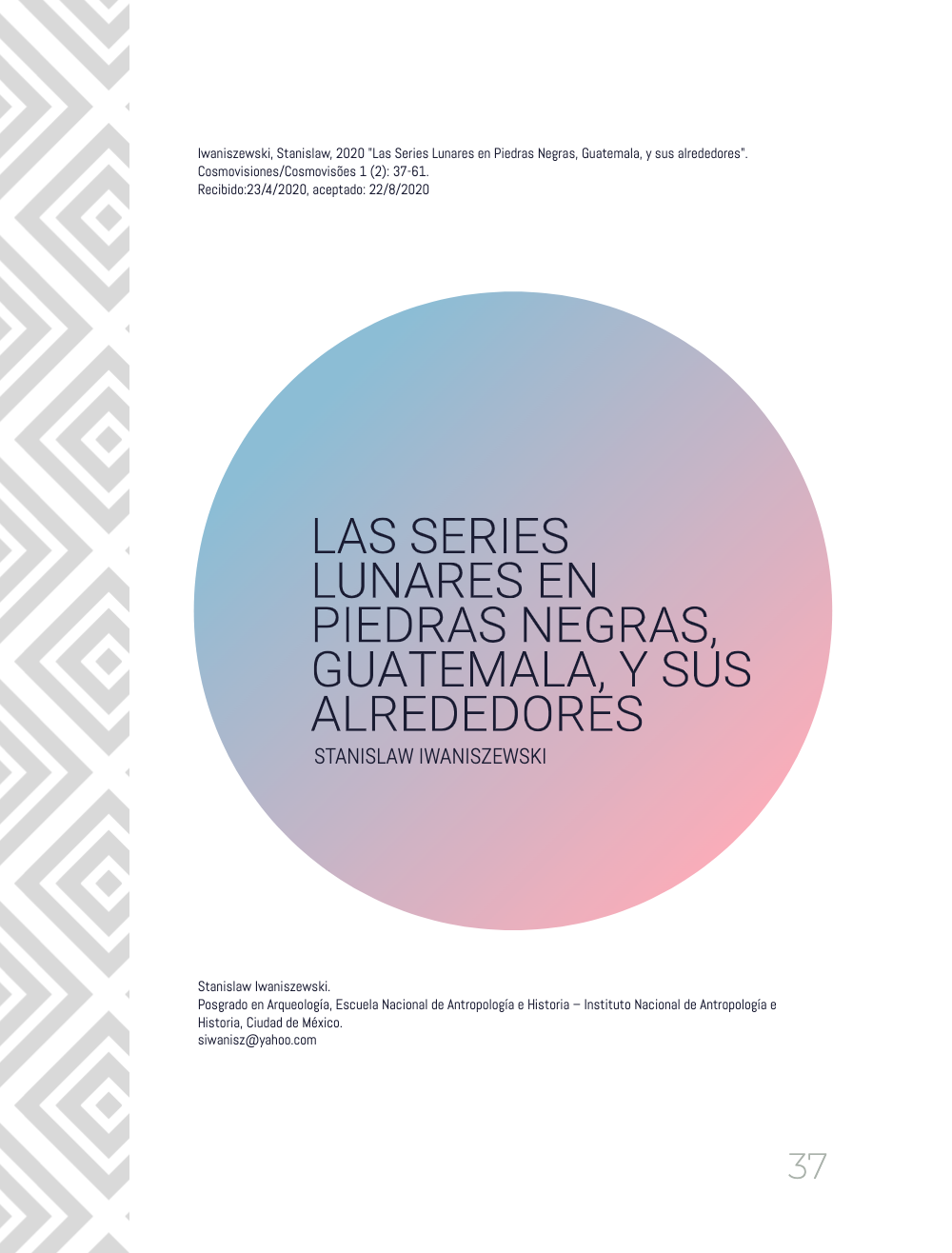Las series lunares en Piedras Negras, Guatemala, y sus alrededores
Palabras clave:
Astronomía maya, Series Lunares, Piedras Negras, Tabla Lunar de XultúnResumen
El estudio de las Series Lunares en Piedras Negras sugiere que los mayas utilizaron el mismo esquema de conteo de los meses lunares desde la fecha la erección de la Estela 30 (534 e.c.) hasta la fecha de la dedicación de la Estela 12 (795 e.c.). Sin embargo, durante el período Clásico Tardío (600-900 e.c.), al acceder al trono algunos de sus gobernantes iniciaron nuevos métodos de cálculo. Estos métodos consistían en modificar el momento de inicio del mes o en cambiar los números de los meses. El presente artículo demuestra que a pesar de los cambios, los mayas mantuvieron intacta la regla de intercalación. El análisis de las Serie Lunar sugiere que el conteo lunar en Piedras Negras puede derivarse de la estructura de la Tabla Lunar de Xultun elaborada mucho más tarde (principios del siglo IX e.c.).
Referencias
Aldana, Gerardo V. 2006 Lunar Alliances: Shedding Light on Conflicting Classic Maya Theories of Hegemony. En: Todd W. Bostwick y Bryan Bates (editores) Viewing the Sky Through Past and Present Cultures. [Pueblo Grande Museum Anthropological Papers, No. 15]. City of Phoenix Parks and Recreation Department, Phoenix, pp. 237-258.
Andrews, E. Willys 1934 Glyph X of the Supplementary Series of the Maya Inscriptions. American Anthropologist, N.S. 36(3): 345-354
Andrews, E. Willys 1951 The Maya Supplementary Series. En: Sol Tax (ed.) The Civilizations of Ancient America, Selected Papers of the 29th International Congress of Americanists (1949). The University of Chicago Press, Chicago, pp. 123-141.
Barthel, Thomas S. 1951 Maya-Astronomie. Lunare Inschriften aus dem Südreich. Zeitschrift für Ethnologie 76: 216-238.
Beyer, Hermann 1935 On the Correlation between Maya and Christian Chronology. Maya Research 2(1) : 64-72.
Beyer, Hermann 1937 Lunar Glyphs of the Supplementary Series at Piedras Negras. El Mexico Antiguo 4(3-4):75-81.
Berlin, Heinrich 1970 Über Mondseriationen bei den Maya. Bulletin Société suisse des Américanistes 34: 3-12.
Biro, Peter 2011 The Classic Maya Western Region: A History. BAR International Series 2308, Archaeopress, Oxford
Brauer, Teutomar 2013 Some New Results Concerning the C- and A-Glyphs in the Lunar Series of the Classic Maya. Mexicon 35(5): 114-116.
Bricker, Harvey R. y Victoria R. Bricker 2011 Astronomy in the Maya Codices. Memoirs of the American Philosophical Society, vol. 265. American Philosophical Society, Philadelphia.
Cases Martín, Juan Ignacio 2001 Analisis de las Series Lunares contenidas en las nociones calendáricas de los textos glíficos mayas del Periodo Clásico. Proyecto de Fin de Carrera, departamento de Astrofísica, Universidad de La Laguna (versión abreviada).
Chinchilla Mazariegos, Oswaldo 2011 Imágenes de la Mitología Maya. Museo Popol Vuh, Universidad Francisco Marroquín, Guatemala.
Clancy, Flora S. 2009 The Monuments of Piedras Negras, an Ancient Maya City. University of New Mexico Press, Albuquerque.
Fuls, Andreas 2007 The Calculation of the Lunar Series on Classic Maya Monuments. Ancient Mesoamerica 18(2): 273-282.
Gaida, María y Deborah Tear 1984 Kalender, Numerologie und lunare Astronomie auf Copán-Monuments. Beiträge zur allgemeinen und viergleichenden Archäologie, Band 6: 309-354.
García Juárez, Sara Isabel 2015 La historia de Piedras Negras a través de sus inscripciones jeroglíficas: auge y ocaso del linaje de las tortugas. Tesis para optar al grado de Licenciado en Historia, Facultad de Filosofía y Letras, Universidad Nacional Autónoma de México, México.
Grube, Nikolai 2018 The Forms of Glyph X of the Lunar Series. Research Note 9. Textdatenbank und Wörterbuch des Klassischen Maya. Arbeitsstelle der Nordrhein-Westfälischen Akademie der Wissenschaften und der Künste an der Rheinischen Friedrich-WilhelmsUniversität Bonn, Bonn. Consultado en 18 de marzo de 2018.
Iwaniszewski, Stanislaw 2004 Glyphs D and E of the Lunar Series at Yachilán and Piedras Negras. Archaeoastronomy, The Journal of Astronomy in Culture 18: 67-80.
Iwaniszewski, Stanislaw 2012 Los ciclos lunares y el calendario maya. Arqueología mexicana 19(118): 38-42
Iwaniszewski, Stanislaw 2015a La Tabla Lunar de Xultún y su comparación con las Series Lunares. En: Luiz C. Borges (org.) Diferentes povos, diferentes saberes na América Latina. Contribuções da atronomia cultural para a história da ciencia.Museu de Astronomia e Ciências Afins – MAST, Rio de Janeiro, pp. 16-31.
Iwaniszewski, Stanislaw 2015b Counting Lunar Phase Cycles in Mesoamerica. En: C.L.N. Ruggles (ed.) Handbook of Archaeoastronomy and Ethnoastronomy. Springer, New York - Heidelberg – Dordrecht – London, Vol.1, pp. 709-714.
Justeson, John S.1989 Ancient Maya ethnoastronomy: an overview of hieroglyphic sources. En: Anthony F. Aveni (ed.) World Archaeoastronomy. Cambridge University Press, Cambridge, pp. 76-129.
Lacadena, Alfonso 2004 Passive Voice in Classic Mayan Texts: CV-h-C-aj and –n-aj Constructions, En: Soren Wichmann (ed.) Linguistics of Maya Writing. University of Utah Press, Salt Lake City, pp. 165-194.
Linden, John H. 1996 The Deity Head Variants of Glyph C. En: Martha J. Macri and Jan McHargue (editors) Eighth Palenque Round Table, 1993. [General Editor: Merle Greene Robertson]. The Pre- Columbian Art Research Institute, San Francisco, pp. 343-356.
Lounsbury, Floyd G. 1978 Maya Numeration, Computation, and Calendrical Astronomy. En: Charles Coulston Gillespie (ed.) Dictionary of Scientific Biography, vol. 15, suppl. 1. Charles Scribner’s Sons, New York. pp. 757-818.
Martin, Simon y Nikolai Grube 2008 Chronicle of the Maya Kings and Queens. Deciphering the Dynasties of the Ancient Maya. Thames and Hudson, New York.
Montgomery, John 1998 The Monuments of Piedras Negras, Guatemala. University of New Mexico, Albuquerque.
Morley, Sylvanus Griswold 1937 The Inscriptions of Peten, Volume V. Carnegie Institution of Washington, Washington.
O’Neil, Meghan E. 2012 Engaging Ancient Maya Sculpture at Piedras Negras, Guatemala. University of Oklahoma Press, Norman.
Pitts, Mark 2011 A Brief History of Piedras Negras As Told by the Ancient Maya: History Revealed in Maya Glyphs. Pre-Columbian Society of the University of Pennsylvania Museum, Philadelphia. Consultado en 21.04.2018.
Robertson, J., Stephen Houston y David Stuart 2004 Tense and Aspect in Maya Hieroglyphic Script. En: Soren Wichmann (ed.) Linguistics of Maya Writing. University of Utah Press, Salt Lake City, pp.259-289.
Rohark, Jens 1996 Die Supplementärserie der Maya. Indiana 14: 53-84.
Satterthwaite, Jr., Linton 1947 Concepts and Structures of Maya Calendrical Arithmetics. Joint Publications of the University of Pennsylvania Museum and the Philadelphia Anthropological Society, No. 3. Philadelphia.
Saturno, William A., David Stuart, Anthony F. Aveni y Franco Rossi 2012a Ancient Maya astronomical tables from Xultun, Guatemala. Science 336(6082): 714- 717.
Saturno, William A., David Stuart, Anthony F. Aveni y Franco Rossi 2012b Supplementary Materials for Ancient Maya Astronomical Tables from Xultun, Guatemala. Science 336(6082): S1-S8.
Schele, Linda, Nikolai Grube, and Federico Fahsen 1992 The Lunar Series in Classic Maya Inscriptions: New Observations and Interpretations. Texas Notes on Pre- Columbian Art, Writing, and Culture No.29.
Stern, Sacha 2012 Calendars in Antiquity: Empires, States, and Societies. Oxford University Press, Oxford.
Stuart, David 1996 Kings of Stone: A Consideration of Stelae in Ancient Maya Ritual and Representation. RES: Anthropology and Aesthetics 29/30: 148-171.
Teeple, John E. 1931 Maya Astronomy. Contributions to American Archaeology, No. 2:29-115. Publication 403. Carnegie Institution of Washington, Washington.
Teufel, Stephanie 2004 Die Monumentalskulpturen von Piedras Negras, Petén, Guatemala. Eine hieroglyphische und ikonographis-ikonologische Analyse. Dissertation zur Erlangung der Dorktorwürde, Philosophishes Fakultät, Rhenischen Friedrich Wilhelms Universität, Bonn.
Thompson, J. Eric S. 1950 Maya Hieroglyphic Writing: An Introduction. Publication, 589. Carnegie Institution of Washington, Washington, D.C.
Villaseñor Montiel, Rafael Eduardo 2012 El conocimiento astronómico de los antiguos mayas: estudio a partir de las Series Lunares. Tesis para optar por el grado de doctor en Estudios Mesoamericanos. Facultad de Filosofía y Letras, Universidad Nacional Autónoma de México, México.

Descargas
Publicado
Número
Sección
Licencia
Los autores que publican en esta revista están de acuerdo con los siguientes términos:
Los autores conservan la autoría intelectual del trabajo y garantizan a la revista el derecho de ser la primera publicación del trabajo.
Los autores pueden compartir el trabajo con un reconocimiento de la autoría y la publicación inicial en esta revista.
Los autores pueden establecer por separado acuerdos adicionales para la distribución no exclusiva de la versión de la obra publicada en la revista (por ejemplo, situarlo en un repositorio institucional o publicarlo en un libro), con un reconocimiento de su publicación inicial en esta revista.
La revista ofrece acceso libre ("open access") a todo su contenido. Los artículos se encuentran disponibles para ser leídos, descargados, copiados, impresos y/o investigados de acuerdo a la licencia Creative Commons: CC BY-NC-SA (Atribución - No Comercial - Compartir Igual-4.0 Internacional)

El contenido de la revista queda completamente disponible a partir de su publicación. Los lectores tienen por obligación citar correctamente a la revista y al autor del contenido descargado















